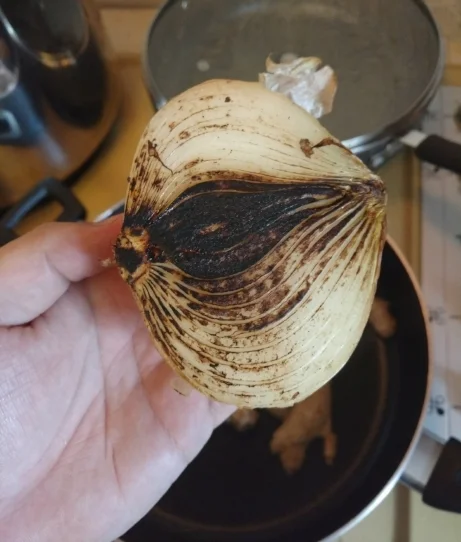QT 48 - Winter Wonder Spice

Why hello there, and welcome to Kitchen Catastrophes Quick Tips. Listen, I don’t know about you guys, but too much continuity, and I start to get a little colicky. And given that I spent the first year of my life screaming in infantile agony from colic, I’m in no hurry to revisit that particular branch of gastrointestinal distress. So after two weeks of talking about…well, gastrointestinal distress, and common consumption constraints, I’m in the mood to wander off and do something new. By which I mean something old.
Like, a year and a half ago, we had a Quick Tip talking about three spices that were in their element at the time: secret spices to spruce up your summer. It was a fun little idea that we never revisited, because, again, continuity and I don’t see eye to eye. But for some reason, it leapt to mind when I had to write in what, exactly, I was writing today, and, like many a sumo, I followed my gut immediately and violently. So let’s visit four spices that, like the spruce, are in their element for winter dishes.
All for One, and One That’s All
I’m going to cheat on this first pick, and go with Allspice. Why is it cheating? Well, because allspice was named that because it tastes like ALL SPICE. Specifically, (and therefore, paradoxically) it tastes like cinnamon, clove, and nutmeg. In fact, if you DON’T have allspice, you can substitute a mixture of those three herbs. I KNOW this is true, because our next recipe actually forces me to use this very trick.
I was going to put a picture of River Song saying "Spoilers" here, but then I honestly forgot until I had already loaded this one. Man, I need to eat before writing these.
Allspice is originally native to the Antilles, also known as “Most of the Caribbean islands you can name” as well as Central America and Mexico. But it was imported all over the world following its discovery. And if you’re not culinary conditioned, let me remind you of where you last had cinnamon, clove, and nutmeg combined: toss in some ground ginger, and you’ve got pumpkin spice. Sure, that makes this somewhat more of a fall spice, but allspice is useful for illustrating a whole family of foods that are great in winter time: warming spices.
Warming spices, in a western understanding, refer to a class of related spices, mostly softer peppers, that grant food a “warm” flavor, many of which also increase circulation. India and China both use the ideas of “warming” and “cooling” foods in different ways, which we’ll probably cover some day, but for now, let’s stick to what we know.
Imagine I had a surprisingly large chorus of high schoolers endorsing the concept of ubiquitous conformity.
So black pepper, ground ginger, allspice, cinnamon, cloves, all of them are warming spices. And they’re all big hitters in savory dishes during the winter: increasing circulation, simply put, keeps you warmer in winter. As such, while allspice is a fantastic and interesting ingredient on its own (Allspice is the core flavoring component of Jamaican Jerk, for instance), I’m really using it to open the door for two related spices: Cinnamon, and Clove, before using Clove to step over to Star Anise. So let’s keep things alphabetical, and face the challenge of Cinnamon next.
Can Jon See Why Kids Love Cinnamon Toast Crunch?
Because marketing tells them they should, and it uses a fundamental flavor pairing of warm and sweet by combining sugar and cinnamon. It’s kind of a dumb question. No one asks why adults love cinnamon rolls. It’s a self-explaining principle: they fucking taste good. Though children have a higher desire for sugar, because their body’s increased growth predisposes them to calorically dense options, while most adults’ tastes shift to more bitter options to maintain mineral balance and so forth. What were we talking about?
Example two for why Jon shouldn't write notes before eating?
Cinnamon. Yes. Sorry, it’s kind of a hard topic to cover: cinnamon is, in many ways, one of the fundamental spices. Salt and Pepper are of course the King and Queens of spices, but Cinnamon is…not far from the throne in that metaphor. People have been importing Cinnamon for FOUR THOUSAND YEARS. And we took it SERIOUSLY back then. We have an inscription of the Temple of Apollo noting how awesome it was that someone offered Cinnamon to the God.
And even today, it’s hard to escape the reach of cinnamon, once the weather carries a chill. I mentioned it was in Pumpkin Spice earlier, but it’s also a common flavoring for oatmeal, one of the primary spices used in making hot spiced cider, one of the components of gingerbread, you find it in French Toast, basically any alcohol named after Fire, and a spree of other uses.
Seriously, it's one of those "no one's marketing team needs to try anymore" events.
The main thing I think gets overlooked with cinnamon in the modern American kitchen is its use in savory applications. Baked goods and sweet drinks, it’s already all over the place, but cinnamon is also used in Mole sauces in Mexico, or in Cinncinati Chili. You can sprinkle it into lamb or beef stews for some rounded warmth, and it’s quite popular in meat dishes all along the Spice Road: from Thailand to Morocco, you’ll find it in tagines, biryani (Indian Fried Rice), noodle soups, and pork rubs. If you’re braising a meat product this winter, consider using a touch of cinnamon and seeing if it warms it up a little.
Is the past tense of Cleave “Cleaved” or “Clove”?
Technically, either work, as well as “Cleft”. Like in the ever-enjoyable to say phrase “cleft in twain”. But I actually wrote that joke before learning that clove actually IS a past tense of cleave. Whoops.
If Cinnamon is the genteel warm smiling face of a Dickensian patrician, bringing warmth and season’s greeting where he gently graces dishes, Clove is his John-Bull-in-a-China-Shop of a nephew: a blunt and brash buffoon, soldiering through other flavors to deliver the taste of cinnamon turned up to eleven, with a hint of aniseed in the background.
People tend to forget John Bull, the Uncle Sam of England.
The black man, as was tragically common in those days, is un-named.
Some like to say that the potency of cloves is “almost medicinal”, which is a stupid thing to say, because cloves have been folk medicine for millennia. Clove oil has been used as an antiseptic, an anesthetic, and an astringent. In some places, the default cure for a tooth or stomach ache is clove oil. Clove isn’t ALMOST anything, damn it. Clove doesn’t half-ass anything, it whole-asses everything it does. Consider that an orange studded with cloves was a portable pomander (Think ‘aromatherapy bottle meets gas mask’) used to overcome the stink and pollution of Renaissance streets: this is a scent that went up against horseshit and regularly won. (Side note: if you want your house to smell fucking fantastic during the winter, simmering the peels of an orange with either clove or cinnamon in about 2-3 cups of water will fill your house with the smell of sweet warmth.)
Pictured: a pomander. Presumably courtesy of Lysander.
In terms of cooking, clove gives cinnamon some back-bone. More than half of the things I listed cinnamon flavoring also bring cloves around to fortify it. Tons of Christmas and Easter hams are studded with sharp cloves, the potency of the little guy cutting the rich pork. Some people drink clove tea, or smoke clove cigarettes. In general, where cinnamon brings warmth, clove borders on heat.
Clove shows up in curries, tagines, cranberry sauces, and plenty of other locales that would probably be quite well received during the chill of December and January. All that heat and warmth could probably use a little sweet to balance it, however, so let’s check out our next concted in this spice brigade, Star Anise.
When you Wish Upon A Star
When I covered summer spices all those months ago, I started with Tarragon, the delicate anise-flavored herb that loves chicken, eggs, and the cool sweetness of summer dishes. Star Anise is not delicate, and what it loves are heat and meat. While biologically unrelated to normal anise, it shares the name because it contains the same flavor components. Interestingly, the vast majority of Star Anise never makes it to culinary markets, as Star Anise is a primary commercial source of Shikimic acid, which is one of the core products used to make Tamiflu.
Which apparently you swallow while HARD.
Yeah, remember when I said Cloves has been used in folk medicine for millennia? Star Anise is CURRENTLY being used in commercial medicine. When it does come out, it…well, it comes in a lot of the same things as cloves and cinnamon. Mulling spices for wine or cider? Often cinnamon, cloves, and star anise. Chinese five spice powder? Cloves, cinnamon, star anise, and two other spices (fennel seeds and Sichuan peppercorns, to be precise.) Star anise flavors biryanis, just like clove and cinnamon. Do you like chai tea? That’s a mixture of cinnamon, clove, star anise, cardamom, ginger and pepper. You can use star anise to intensify coffee flavors by just leaving it in the bottom of the pot. One big dish that I think would be a delightful winter meal is pho, the Vietnamese noodle soup, which is made using a beef broth flavored with CINNAMON AND STAR ANISE. And Sometimes clove. Also, blackened ginger and onion…interestingly, we’ll have an opportunity to talk about this soon. I accidentally made set-ups to TWO recipes I’ve previously made but never posted in this post.
And yes, as I have to keep saying: this is NOT, despite appearances, failure.
And those are the spices I wanted to talk about this post: three spices that tend to hang out, and will be in quite a few dishes you dine on or drink in the coming months, and several more exotic ones you could slot in for a bit of variety. And that’s what made them so appealing to me: they’re familiar, to most people, but also used in new and exciting dishes, so they can serve as a gateway, or as a warning: if you like the taste of mulled apple cider, you may like lamb tagine. If you don’t like Chinese Five Spice, maybe avoid pho. (Though, hopefully you don’t, because pho is pretty fucking rad.) So hopefully these four flavor fighters help warm your winter meals, and Merry Christmas, everyone!













